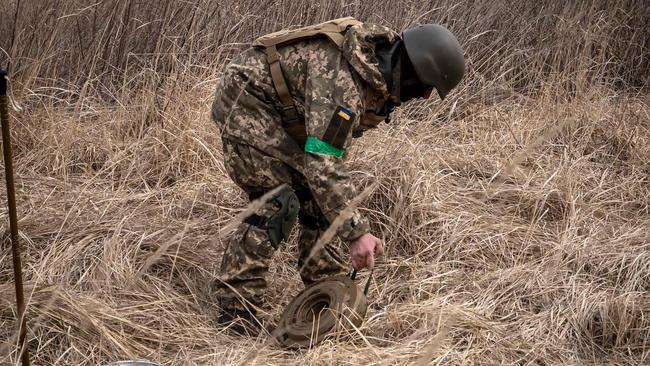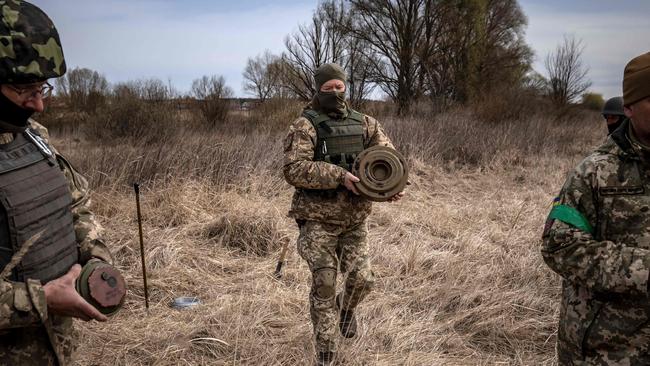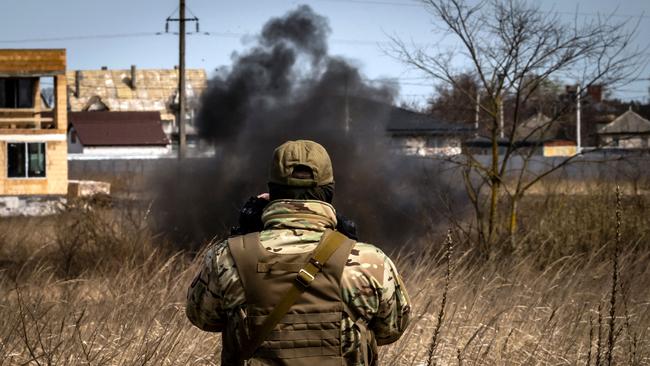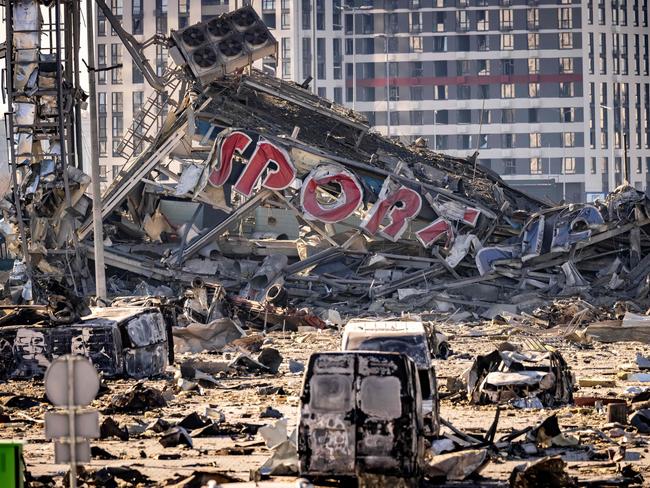Walking in the footsteps of Kyiv’s Hurt Locker heroes
To onlookers it resembles a scene from the Oscar-winning film about a maverick bomb disposal unit in Iraq. For Roman Horiak, it is all in a day’s work.

Everything seems to stand still as the two men in overalls and body armour crouch around the hole in the floor of Irina Lebvedev’s small kitchen and lever up the tiles.
The Russian shell smashed through a roof, a ceiling and the floor without exploding so they are confident they will not set it off but, just in case, they tell Irina’s grandson and others to stand back. Even Irina’s cat stops mewing and for a moment the only sound is the men’s breathing as they reach down for the 122mm shell, pull out the fuse then carry it outside.
To onlookers it resembles a scene from The Hurt Locker, the Oscar-winning film about a maverick bomb disposal unit in Iraq. For Roman Horiak, 31, leader of the five-man team removing Russian mines and ordnance in Bucha and Irpin, suburbs of Kyiv that are now synonymous with the invaders’ atrocities, it is all in a day’s work.
Twenty minutes earlier he had been perched precariously on a tenth-floor balcony trying to reach another unexploded shell. Irina’s kitchen is his 20th bomb disposal that day. Over the three weeks since the Russians retreated from the outskirts of the capital his team have often cleared 200-300 a day. They used to average five a month.

It is becoming clear that not only did the Russian forces carry out rapes, torture and summary killings during their month-long occupation – bodies are still found every day – but that they are also responsible for a legacy that may kill and maim people for decades.
Horiak, who has a five-year-old son, shrugs off the danger of his work. “It’s not like Storm in the Desert,” he smiles, referring to the local name for Kathryn Bigelow’s film. But the risks are real: three of his fellow de-miners were killed in Kharkiv last week.
Two months of war in Ukraine have generated what experts say is the biggest volume of unexploded ordnance in Europe since 1945.
Partly it is the astonishing failure rate of Russian artillery: a lot of their bombs did not go off. Partly it is the dangers presented by shot-down helicopters still bearing their missile-load. Most of all, however, it is the terrifying array of mines the Russians left behind, including those that send out spinning discs designed to slice through body armour, those used to booby trap children’s toys, appliances such as washing machines rigged to
explode as the user opens the door, and new smart mines known as “two steps” that react to human weight and can be safely removed only by robots. Some mines were laid by Ukraine in defence – a standard tactic – but were mapped and have been removed.

“It’s colossal,” says James Cowan, head of the Halo Trust, the world’s largest de-mining charity, who visited Ukraine last week. “This will take years but we don’t have years as people want to return home, reopen their factories and plant their fields.”
Aleksandr Bahri, head of de-mining for Ukraine’s state emergency services, which have only 535 specialists, estimates that 300,000 sqkm need de-mining – almost half the country. Halo believes the area affected may be 100,000 sqkm. “We are still working on mines left in the Second World War,” Bahri says.
The Ukrainian military estimates the total cost of removal at up to dollars 250 billion. It has a further 600 de-miners but they are busy fighting or clearing recaptured bases.
Horiak’s team started by clearing schools, the water supply, playgrounds and public buildings but are now responding to applications from residents trying to return home. They work on ballistic missiles, shells, mines, rockets, IEDs and hand grenades. In a multistorey car park they found a booby-trapped antitank rocket.
The team used to be underwater specialists, clearing rivers, and Horiak had been planning a new career. “Now I am needed,” he says. “Every Ukrainian has managed to find their role in defending Ukraine and this is mine. This is personal. I started living in Irpin in 2014, it’s where I got married, where my son was born, and rented my first house which is now destroyed. I don’t have words for what happened.”

The main streets have been cleared, the Wi-Fi restored and municipal workers are busy repairing powerlines but many apartment blocks are blackened and derelict and the sense of death is everywhere. As Horiak and his team clear mines, police continue to find bodies – so many that the mortuary is full and body bags are being loaded into refrigerated trucks, some with feet hanging out of the ends. On Friday women waited in the cold rain outside one of the trucks, as mortuary workers in hazmat suits sort through the bags.
Tanya, 37, lost her husband and a five-year-old son, whom she had taken 12 years to conceive. “They had gone to the garage and were standing round the stove to cook food and get warm and a rocket came,” she said.
A white tent has been erected outside the mortuary for relatives to identify missing family members. On a table inside is a stapled list of bodies found as well as a list of those missing and packets of tissues. Olena Krushanovska, a volunteer psychologist, waits on standby, tearful at what she has heard. Outside a policeman showed grisly photos on his phone to a woman looking for her husband. The centre is run by Mykolaina Skoryk, who is the mayor of Bucha’s digital adviser but like so many Ukrainians finds herself doing things she never imagined. “We’ve never had so many bodies,” she says. “We collected 412 in the last few weeks. Normally we get seven a month.”
As she speaks, one widow, Tatiana Adolphovica, 51, becomes so desperate that she insists on climbing into the truck of bodies and looking in the foul-smelling bags. She has been searching for three weeks for the body of her husband Mykola, an electrician, who was abducted by Russians from their village because he had been videoing what was going on. “He was taken to another village and kept with four others in a cellar where they were tortured, then their heads bashed in as the Russians left. The local priest saw their bodies but now I can’t find him anywhere. I won’t rest until I do. He was my big love.”
THE SUNDAY TIMES

To join the conversation, please log in. Don't have an account? Register
Join the conversation, you are commenting as Logout